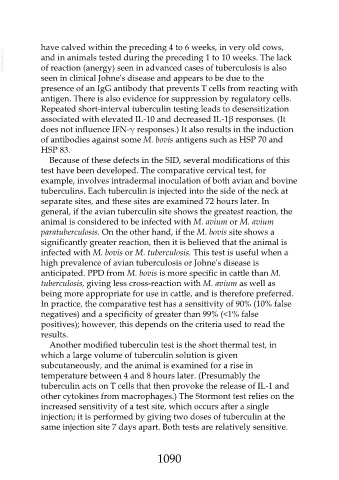Page 1090 - Veterinary Immunology, 10th Edition
P. 1090
have calved within the preceding 4 to 6 weeks, in very old cows,
VetBooks.ir and in animals tested during the preceding 1 to 10 weeks. The lack
of reaction (anergy) seen in advanced cases of tuberculosis is also
seen in clinical Johne's disease and appears to be due to the
presence of an IgG antibody that prevents T cells from reacting with
antigen. There is also evidence for suppression by regulatory cells.
Repeated short-interval tuberculin testing leads to desensitization
associated with elevated IL-10 and decreased IL-1β responses. (It
does not influence IFN-γ responses.) It also results in the induction
of antibodies against some M. bovis antigens such as HSP 70 and
HSP 83.
Because of these defects in the SID, several modifications of this
test have been developed. The comparative cervical test, for
example, involves intradermal inoculation of both avian and bovine
tuberculins. Each tuberculin is injected into the side of the neck at
separate sites, and these sites are examined 72 hours later. In
general, if the avian tuberculin site shows the greatest reaction, the
animal is considered to be infected with M. avium or M. avium
paratuberculosis. On the other hand, if the M. bovis site shows a
significantly greater reaction, then it is believed that the animal is
infected with M. bovis or M. tuberculosis. This test is useful when a
high prevalence of avian tuberculosis or Johne's disease is
anticipated. PPD from M. bovis is more specific in cattle than M.
tuberculosis, giving less cross-reaction with M. avium as well as
being more appropriate for use in cattle, and is therefore preferred.
In practice, the comparative test has a sensitivity of 90% (10% false
negatives) and a specificity of greater than 99% (<1% false
positives); however, this depends on the criteria used to read the
results.
Another modified tuberculin test is the short thermal test, in
which a large volume of tuberculin solution is given
subcutaneously, and the animal is examined for a rise in
temperature between 4 and 8 hours later. (Presumably the
tuberculin acts on T cells that then provoke the release of IL-1 and
other cytokines from macrophages.) The Stormont test relies on the
increased sensitivity of a test site, which occurs after a single
injection; it is performed by giving two doses of tuberculin at the
same injection site 7 days apart. Both tests are relatively sensitive.
1090

